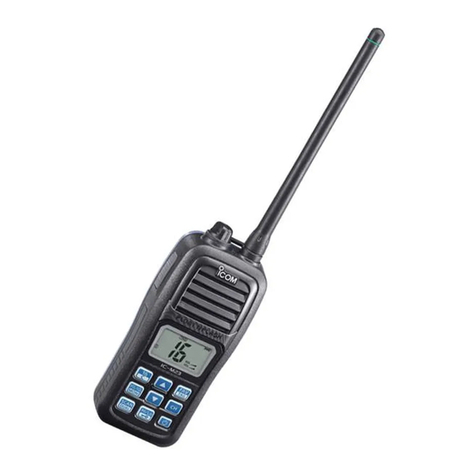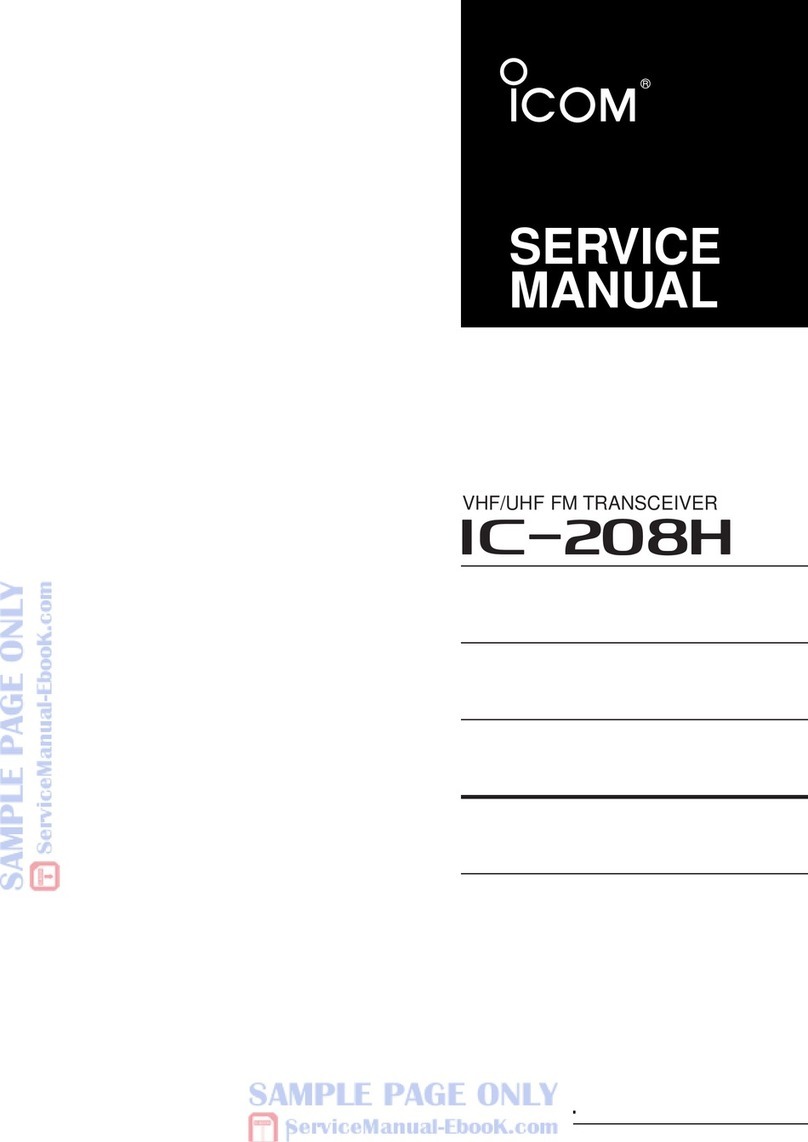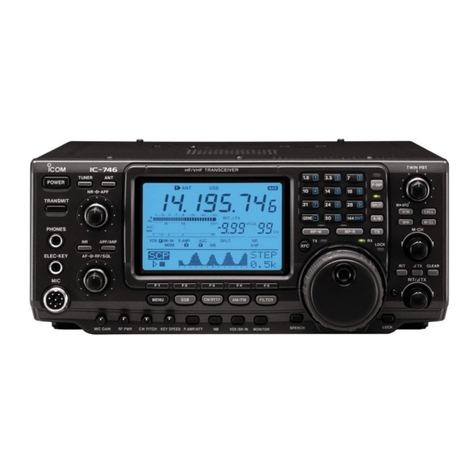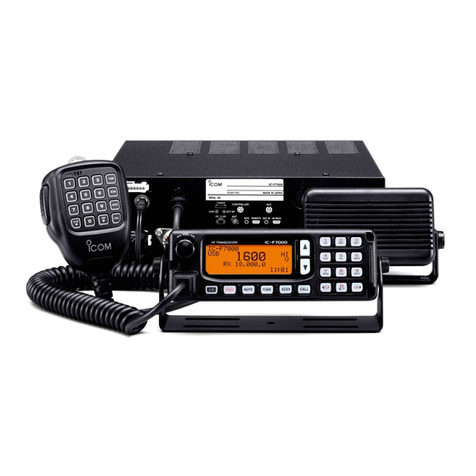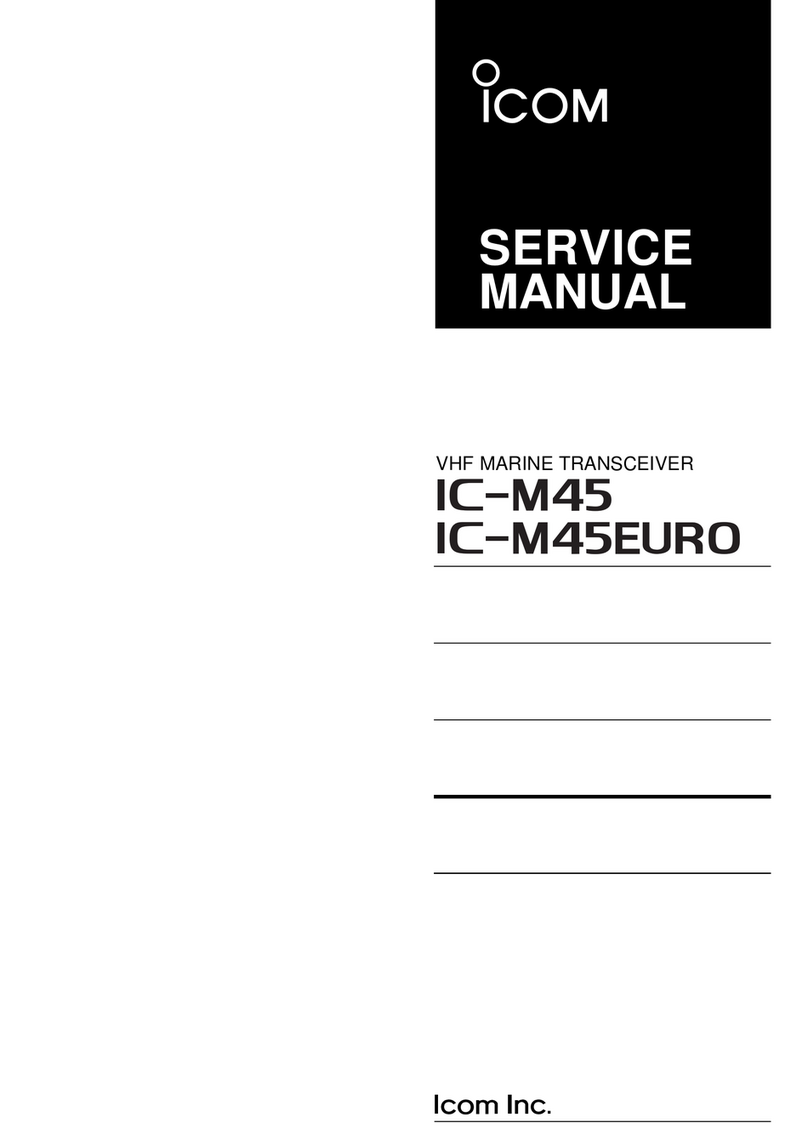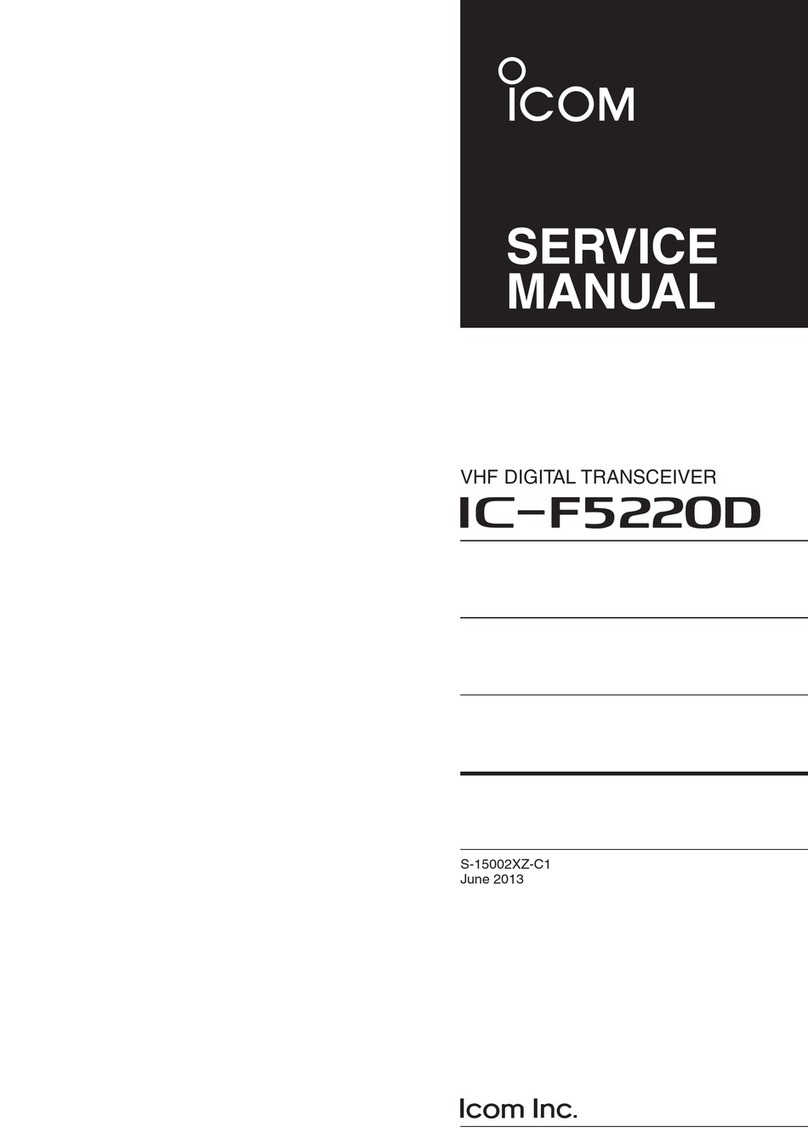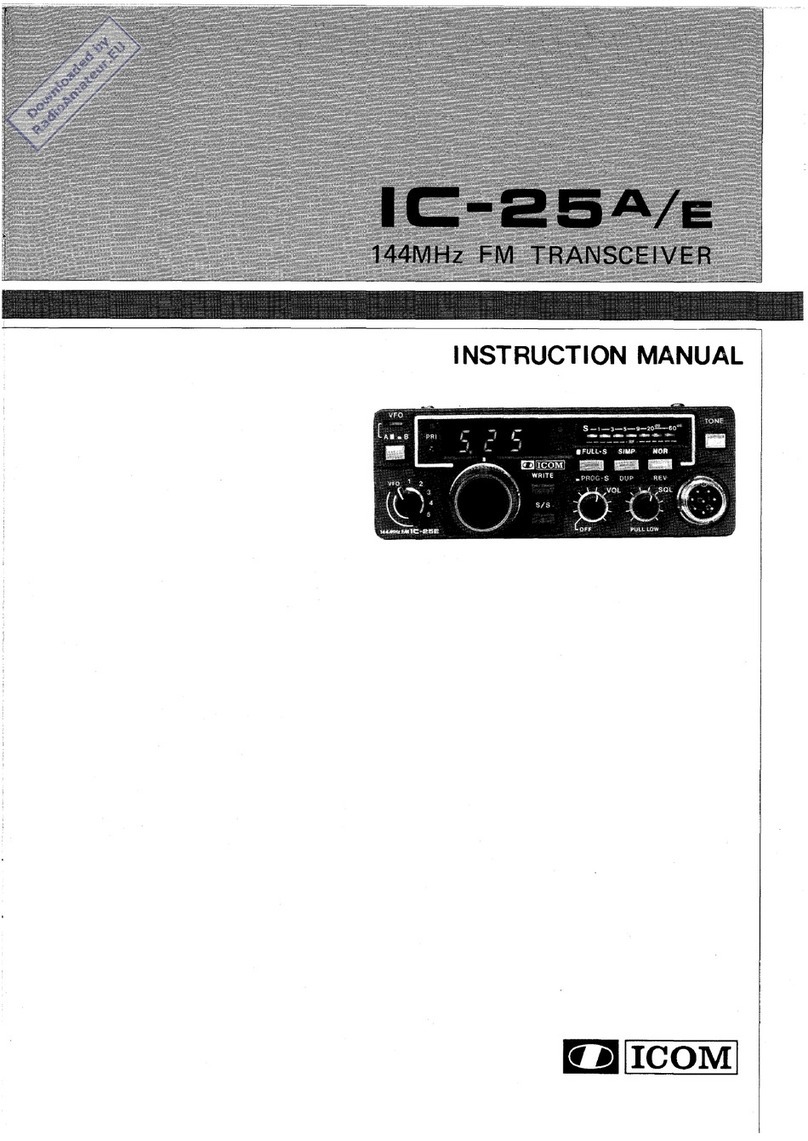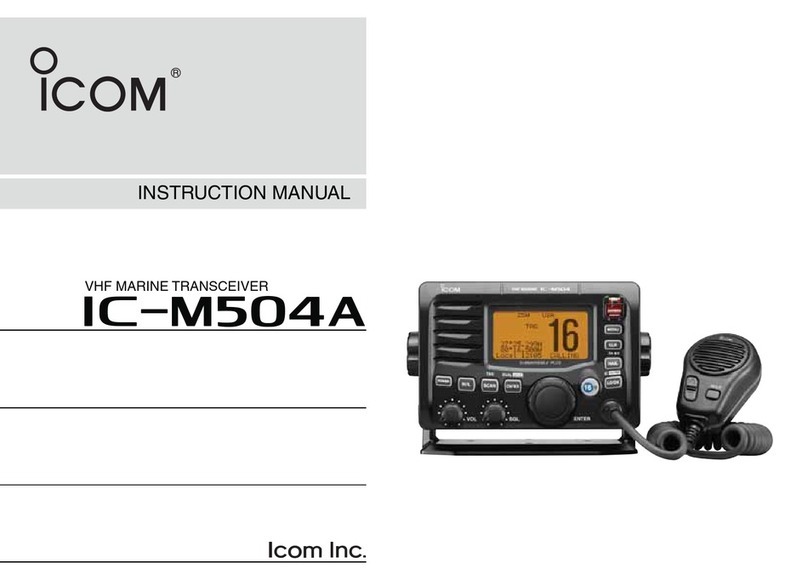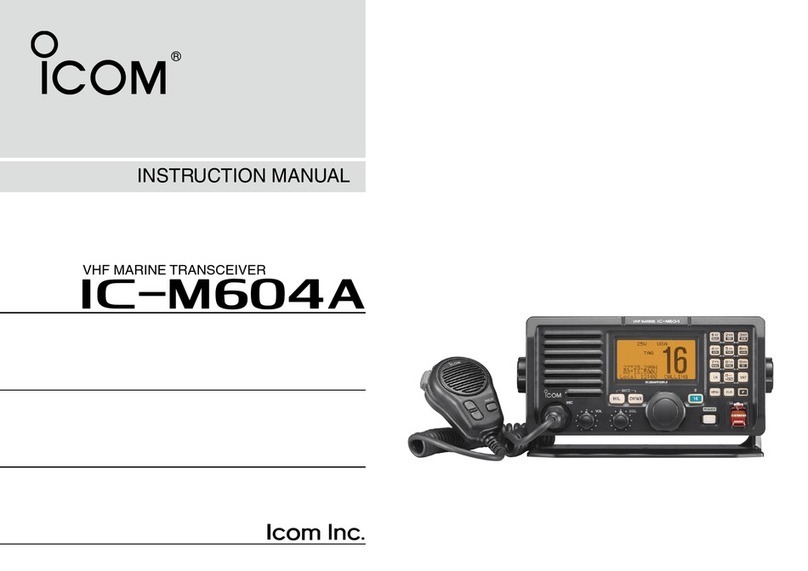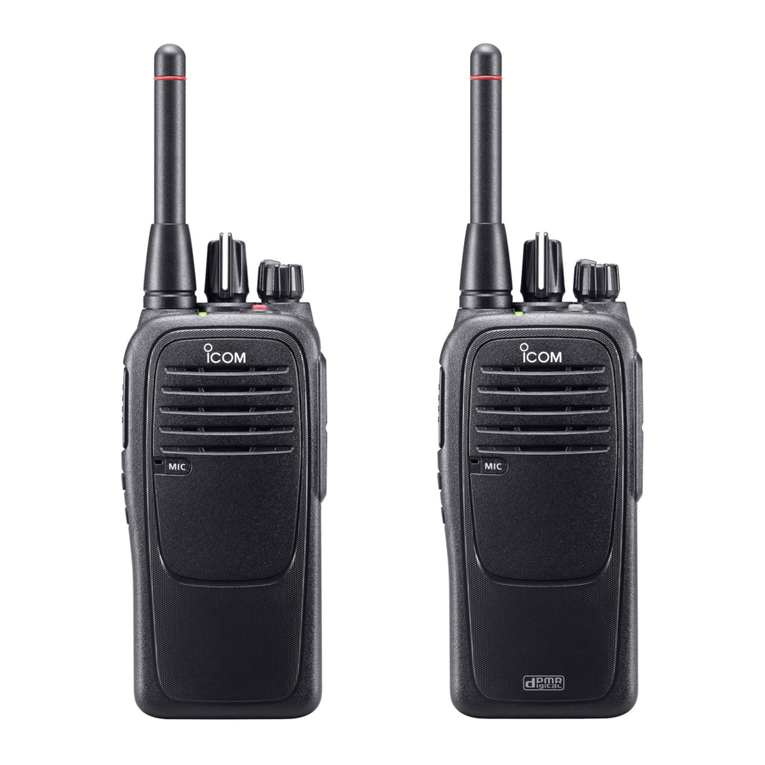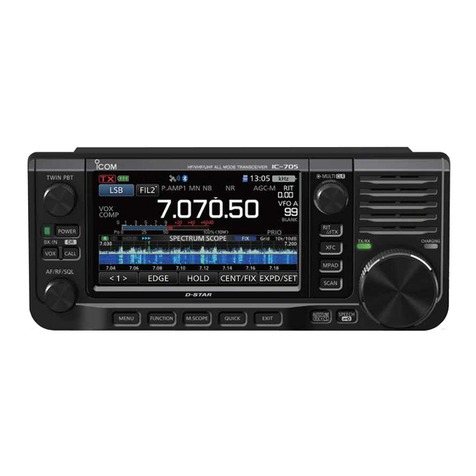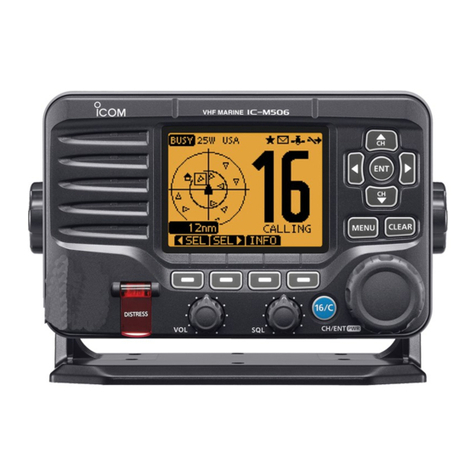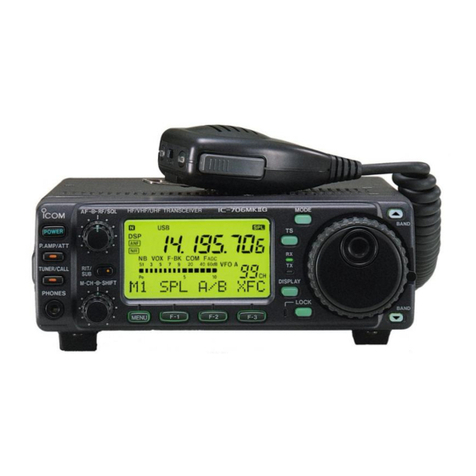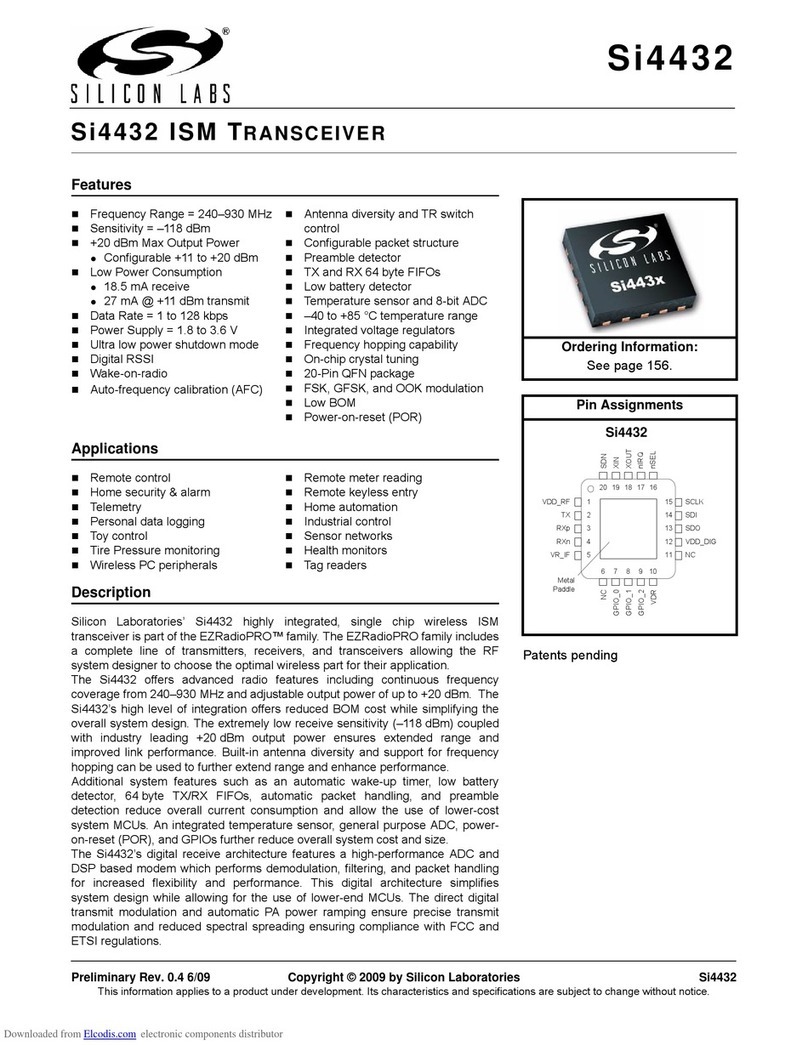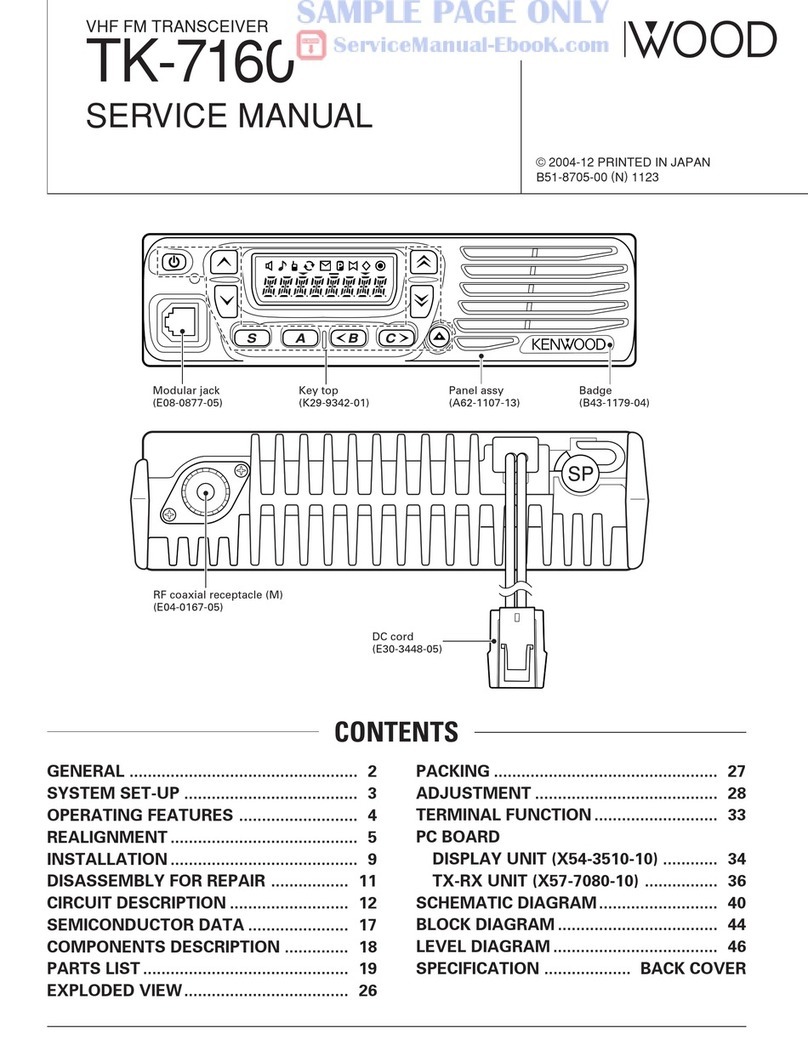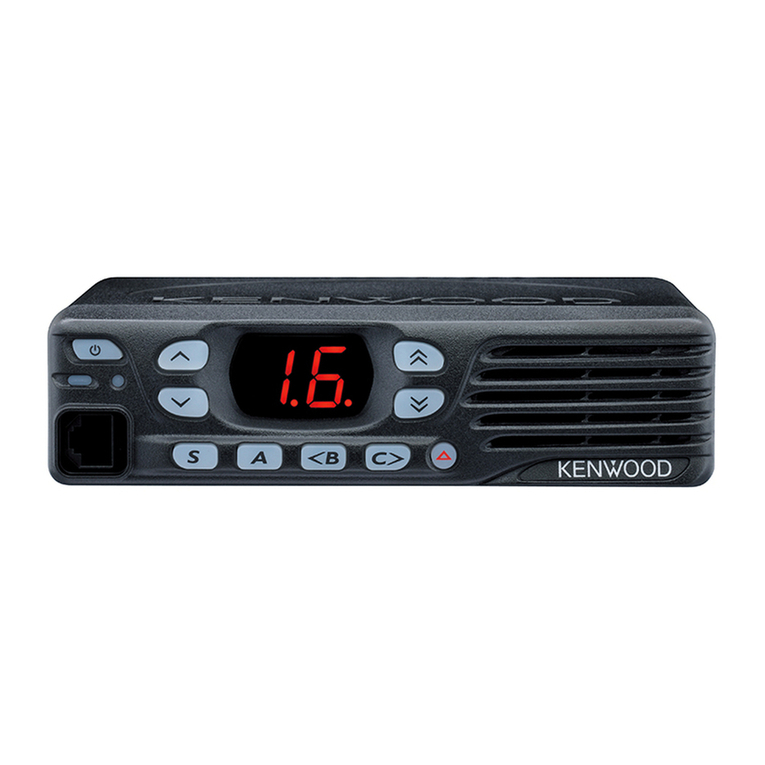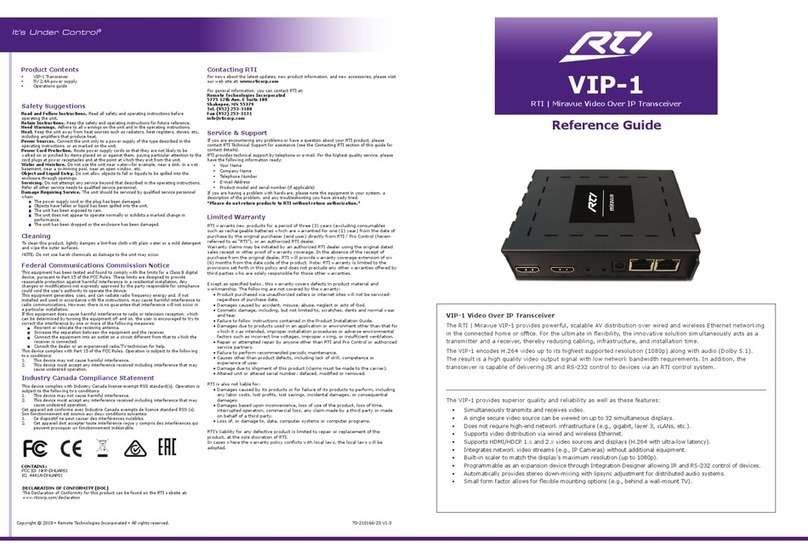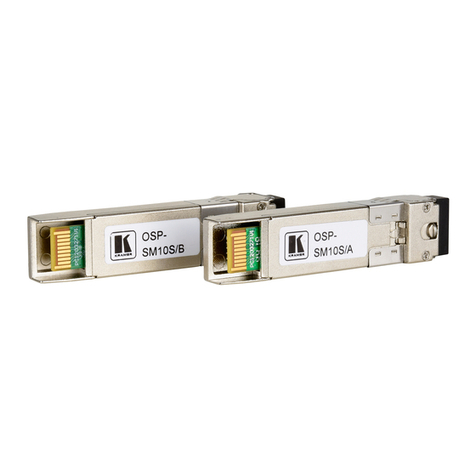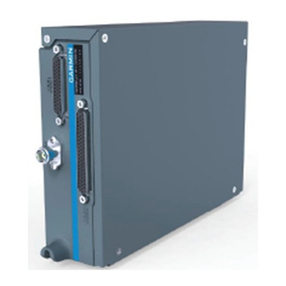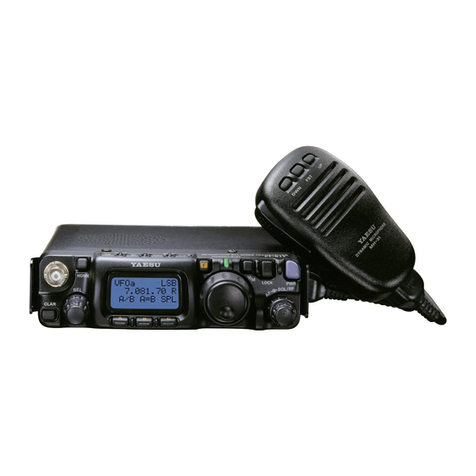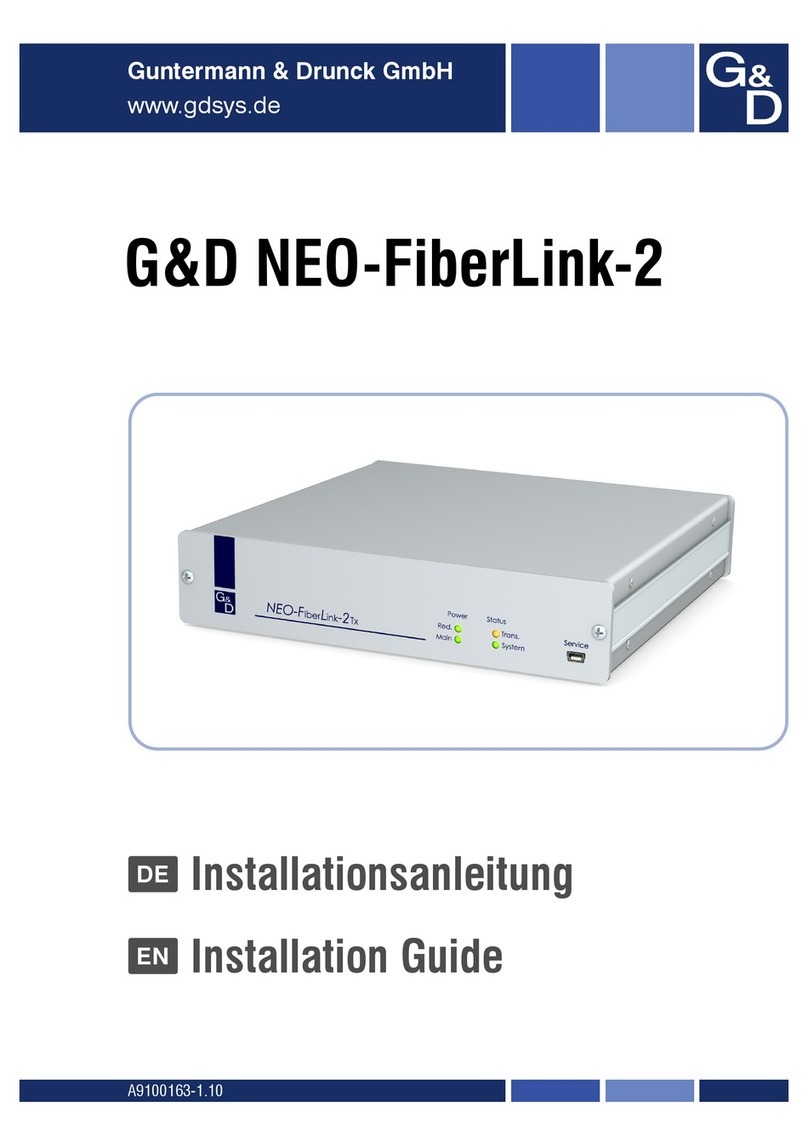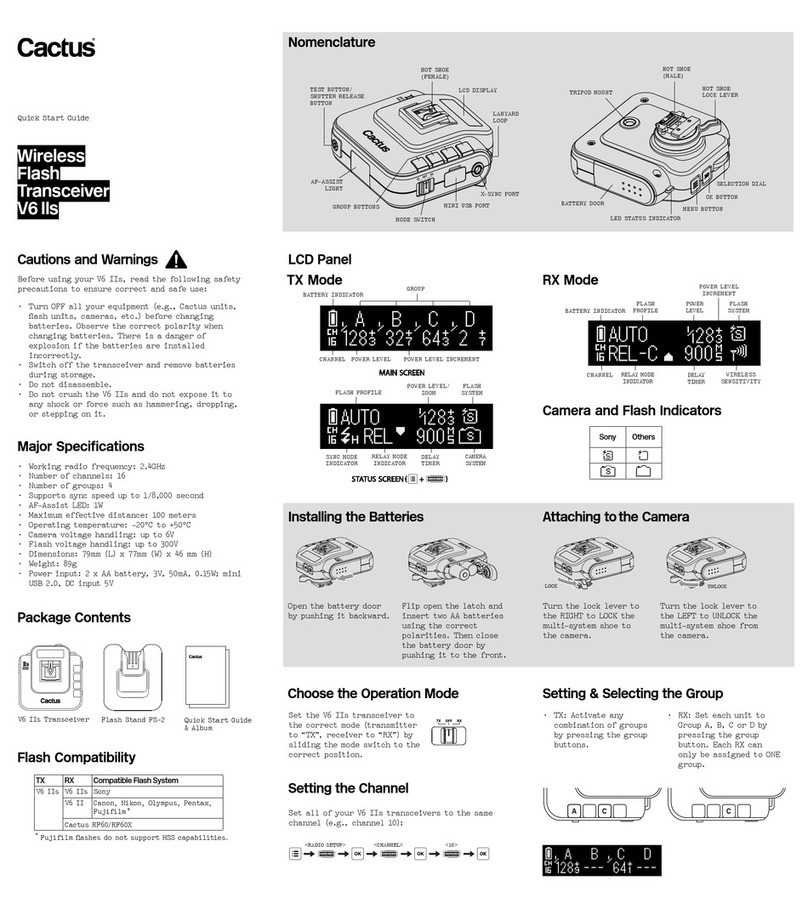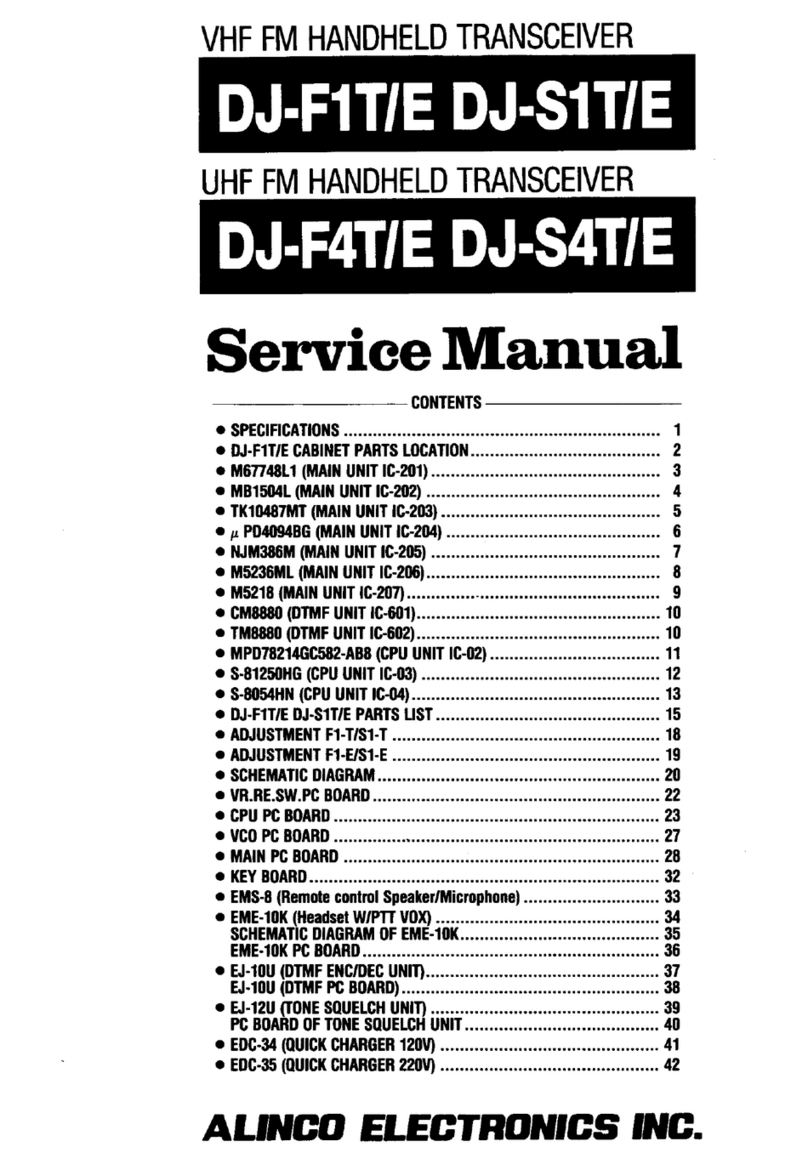Icom IC-M59 User manual

INSTRUCTION MANUAL
iC- m59
VHF MARINE TRANSCEIVER

IN CASE OF EMERGENCY
i
If your vessel requires assistance, contact other vessels and
the Coast Guard by sending a distress call on channel 16.
Or, transmit your distress call using digital selective calling on
channel 70 (the optional UX-120
DSC UNIT
must be installed).
❍
USING CHANNEL 16
DISTRESS CALL PROCEDURE
1. “MAYDAY MAYDAY MAYDAY”
2. “THIS IS - - - - - - - - - - - - - - ” (name of vessel)
3. Your call sign or other indication of the vessel
(AND 9-digit DSC ID if you have one).
4. “LOCATED AT - - - - - - - - - - ” (your position)
5. The nature of the distress and assistance re-
quired.
6. Any other information which might facilitate the
rescue.
❍
USING DIGITAL SELECTIVE CALLING (ch 70)
(UX-120 required)
DISTRESS CALL PROCEDURE
1. Push and hold [16•
EMER
] for 5 sec. until you
hear 5 short beeps change to one long beep.
2. Then, push [PTT] to transmit the call.
3. Wait for an acknowledgment from a coast sta-
tion.
• When received, channel 16 is automatically selected.
4. Push and hold [PTT], then transmit the appro-
priate information as at left.

ii
TABLE OF CONTENTS
IN CASE OF EMERGENCY ..................................................i
TABLE OF CONTENTS ...................................................... ii
IMPORTANT ...................................................................... iii
CAUTIONS.......................................................................... iii
1 OPERATING RULES ..................................................... 1
2 PANEL DESCRIPTION ............................................ 2 – 5
■Front panel ................................................................. 2
■Microphone ................................................................. 3
■Function display .......................................................... 4
3 BASIC OPERATION .............................................. 6 – 11
■Power ON ................................................................... 6
■Channel selection ....................................................... 6
■Receiving .................................................................... 8
■Transmitting ................................................................ 9
■Scan function ............................................................ 10
■Call channel programming ........................................ 11
■Display backlighting .................................................. 11
4 DIGITAL SELECTIVE CALLING ......................... 12 – 18
■General ..................................................................... 12
■Distress call transmission ......................................... 13
■All ships call transmission ......................................... 14
■Individual call transmission ....................................... 15
■Receiving DSC calls ................................................. 16
5 SET MODE ........................................................... 19 – 21
■Entering SET mode .................................................. 19
■SET mode items ....................................................... 19
6 CONNECTIONS AND MAINTENANCE .............. 22 – 27
■Unpacking ................................................................ 22
■Additional requirements ............................................ 22
■Connections .............................................................. 23
■Mounting the transceiver .......................................... 24
■Dimensions ............................................................... 25
■Antenna .................................................................... 26
■Fuse replacement ..................................................... 26
■Cleaning ................................................................... 26
■Optional unit installations .......................................... 26
7 TROUBLESHOOTING ................................................ 28
8 VHF MARINE CHANNEL LIST ................................... 29
9 SPECIFICATIONS ....................................................... 30
10 OPTIONS ................................................................... 31

WHEN INSTALLING THE DSC UNIT
NEVER transmit a distress call when your vessel does not
need immediate help. Distress calls can be used only in times
of emergency.
AVOID using or placing the transceiver in direct sunlight or
in areas with temperatures below –20°C (–4°F) or above
+60°C (+140°F).
DO NOT operate the transceiver without running the ves-
sel’s engine. When your vessel’s engine is OFF and the
transceiver is transmitting, the vessel’s battery will soon be-
come exhausted.
KEEP the transceiver out of the reach of children.
KEEP the antenna cable and DC power cable as far away
as possible from electrical pumps, generators and other elec-
tronic instruments to prevent instrument malfunctions.
KEEP the transceiver and microphone at least 1 meter
away from your vessel's magnetic navigation compass.
iii
IMPORTANT
READ ALL INSTRUCTIONS carefully and com-
pletely before using the transceiver.
SAVE THIS INSTRUCTION MANUAL—This in-
struction manual contains important operating instructions for
the IC-M59.
YOU MUST HAVE a DSC vessel ID in order to oper-
ate the optional DSC functions of the transceiver. See your
Dealer for details.
CAUTIONS
RWARNING NEVER connect the transceiver to an
AC outlet. This may pose a fire hazard or result in an electric
shock.
RWARNING HIGH VOLTAGE! NEVER touch
the antenna or an internal antenna connector during trans-
mission. This may result in an electric shock or a burn.
NEVER connect the transceiver to a power source of more
than 16 V DC. This connection will ruin the transceiver.

OPERATING RULES 1
1
DPriorities
• Read all rules and regulations pertaining to priorities and
keep an up-to-date copy handy. Safety and distress calls
take priority over all others.
• You must monitor channel 16 when you are not operating
on another channel.
• False or fraudulent distress calls are prohibited under law.
DPrivacy
• Information overheard but not intended for you cannot law-
fully be used in any way.
• Indecent or profane language is prohibited.
DRadio licenses
SHIP STATION LICENSE
When your craft is equipped with a VHF FM transceiver, you
must have a current radio station license before using the
transceiver. It is unlawful to operate a ship station which is not
licensed.
Inquire through your dealer or the appropriate government
agency for a Ship-Radiotelephone license. This license in-
cludes the call sign which is your craft’s identification for radio
purposes.
OPERATOR’S LICENSE
A restricted Radiotelephone Operator Permit is the license
most often held by small vessel radio operators when a radio
is not required for safety purposes.
The Restricted Radiotelephone Operator Permit must be
posted near the transceiver or be kept with the operator. Only
a licensed radio operator may operate a transceiver.
However, non-licensed individuals may talk over a transceiver
if a licensed operator starts, supervises, ends the call and
makes the necessary log entries.
A current copy of the applicable government rules and regu-
lations is only required to be on hand for vessels in which a
radio telephone is compulsory. However, even if you are not
required to have these on hand it is your responsibility to be
thoroughly acquainted with all pertinent rules and regulations.

PANEL DESCRIPTION
2
2
➊CHANNEL SELECTOR [CHANNEL]
Selects an operating channel in the selected channel
group.
➋SCAN SWITCH [SCAN•TAG]
• Starts and stops normal or priority scan when tag chan-
nels are programmed. (p. 10)
• Push and hold for 1 sec. to toggle the tag setting for the
displayed channel. (p. 10)
➌HIGH/LOW POWER SWITCH [HI/LO•DIM]
• Toggles between high and low output powers. (p. 9)
• While pushing, rotate the channel selector to adjust the
display and control/switch backlighting intensity. (p. 11)
➍CHANNEL/WEATHER CHANNEL SWITCH
[CH/WX•U/I/C]
• Selects and toggles between regular and weather chan-
nels.
• Selects one of 3 regular channels in sequence when
pushed for 1 sec. (p. 7)
➠International, U.S.A. and Canadian channels are available for
regular channels.
➎DUAL/TRI-WATCH SWITCH [DUAL•TRI](p. 8)
• Activates dualwatch for checking channel 16.
VHF
TAG TRI
U/I/CDIM
ALL
/IND
EMER
16
9
SQUELCH
OFF
PWR/VOL
SCAN
HI/LO CH/WX
DUAL
MARINE
➋➌
➍➎➏ ➐ ➑
➒
➊
■Front panel

■Microphone
HI/LO
➊
➋
2
PANEL DESCRIPTION
3
•Push and hold for 1 sec. to activate tri-watch for checking
channel 16 and the call channel.
➏CALL CHANNEL SWITCH [9•ALL/IND]
•Selects the call channel—the call channel is programma-
ble, channel 9 being the default. (p. 11)
•Push and hold for 1 sec. to enter the standby condition of
a DSC call. (When an optional UX-120 is installed).
(pgs. 14, 15)
➠Both “All ships call”and “Individual call”are selectable.
➐CHANNEL 16 SWITCH [16•EMER]
•Selects channel 16. (p. 6)
•Push and hold to enter the standby condition for a dis-
tress call transmission using the DSC function (when an
optional UX-120 is installed). (p. 13)
➑SQUELCH CONTROL [SQUELCH]
•Rotate clockwise to eliminate audio noise. (p. 8)
•Activates the built-in attenuator when rotated deep clock-
wise. (p. 8)
➒POWER/VOLUME CONTROL [PWR/VOL]
Turns power ON and OFF and adjusts the audio output
level. (p. 6)
➊CHANNEL UP/DOWN SWITCHES [▼]/[▲]
•Select an operating channel in the selected channel
group.
➠These switches can be used instead of the transceiver’s
channel selector.
➋HIGH/LOW POWER SWITCH [HI/LO]
The same function as the transceiver’s front panel.
•Toggles between high and low output powers. (p. 9)
•While pushing, push the [▼]/[▲]switches to adjust the display
and control/switch backlighting intensity. (p. 11)

2PANEL DESCRIPTION
4
qTRANSMIT INDICATOR
Appears while transmitting. (p. 9)
wBUSY INDICATOR
Appears when receiving a signal or when [SQUELCH] is
rotated too far counterclockwise. (p. 8)
eCHANNEL INDICATOR
Shows the operating channel. (pgs. 6, 7)
rTAG CHANNEL INDICATOR
Appears when the selected channel is set as a tag chan-
nel. (p. 10)
tSCAN INDICATOR
Appears and flashes during scan operation. (p. 10)
yDUALWATCH INDICATOR
Appears and flashes during dualwatch operation. (p. 8)
uTRI-WATCH INDICATOR
Appears and flashes during tri-watch operation. (p. 8)
iVOICE SCRAMBLER INDICATOR
Appears while the optional voice scrambler is activated.
(p. 8)
LOW CALL
CANUSA
INT
ALTWX
TX
TAG
DUAL
SCAN
DUP ACK RCV
SCRM
TRI
BUSY
qewrtyu
i
o
!0
!1
!2
!3
!4
!5
!6
■Function display

5
2
PANEL DESCRIPTION
oDUPLEX INDICATOR
Appears when the selected channel is a duplex channel.
!0 ACKNOWLEDGEMENT/RECEIVE INDICATORS
Appear during optional DSC operation. (pgs. 13–18)
•“RCV”appears when a DSC call is received.
•“ACK RCV”appears when an acknowledgement is received.
•“ACK”and “$”appear when transmitting an acknowledge-
ment.
!1 DSC INDICATORS (pgs. 13–18)
Appear during optional DSC operation and show a format
specifier, message, etc.
!2 NMEA INDICATOR
Appears when NMEA devices (such as a GPS receiver)
are connected. (p. 12)
!3 WEATHER ALERT INDICATOR
Indicates the weather alert function is activated. (p. 7)
!4 MODE INDICATORS (p. 7)
•“USA”shows USA channels are selected.
•“CAN”shows Canadian channels are selected.
•“INT”shows International channels are selected.
•“WX”shows weather channels are selected.
!5 LOW POWER INDICATOR
Shows that low output power is selected. (p. 9)
!6 CALL CHANNEL INDICATOR
Appears when the call channel is selected. (p. 6)

■Channel selection
DChannel 16
Channel 16 is the distress channel. It is used for establishing
initial contact with another station and for emergency com-
munications. Channel 16 is monitored during dualwatch/tri-
watch. While standing by you are required to monitor channel
16.
DCall channel
The call channel is used to store your most often-used chan-
nel for quick recall. In addition, the call channel is monitored
during tri-watch. The default setting for the call channel is
channel 9 which is for pleasure use.
BASIC OPERATION
3
6
■Power ON
➀Rotate [PWR/VOL] clockwise to turn power ON.
➁Operate the transceiver as indicated in the following sec-
tions.
DLow voltage indicator
When “b”appears and flashes as
shown at right, there is a DC power
source problem. In this case, check
your vessel’s battery and DC
power cable.
LOW CALL
CANUSA
USA
INT
ALTWX
TX
TAG
DUAL
SCAN
DUP ACK RCV
SCRM
TRI
BUSY All display indications
appear briefly*.
*“SCRM”appears only when an optional
UT-79 is installed.
“dSC”appears only when an optional
UX-120 is installed.
USA
Push
or hang the microphone
on the microphone hanger.
16
Push
CALL
USA
“CALL”indicates that the
call channel is selected.
9
USA

3
BASIC OPERATION
7
DU.S.A., Canadian and international channels
There are 61 U.S.A., 57 Canadian and 57 international chan-
nels. These channel groups may be specified for the operat-
ing area.
➀Push [CH/WX] to select a regular channel.
•If a weather channel appears, push [CH/WX] again.
➁Rotate the channel selector to select a channel.
•“DUP”appears for duplex channels.
➂To change the channel group, push [CH/WX•U/I/C] for 1
sec.
•U.S.A., Canadian and international channels can be selected in
sequence.
DWeather channels
There are 10 weather channels. These are used for monitor-
ing NOAA (National Oceanographic and Atmospheric
Administration) weather broadcasts.
✔CONVENIENT
Weather alert function: NOAA broadcast stations transmit
a weather alert tone before an important weather announce-
ment.
When the weather alert function is turned ON, the “ALT”indi-
cator flashes until any key is pushed.
This function is activated when a weather channel is selected
or during any scan. See “SET mode items”on p. 19.
USA
INT
DUP
CAN
TAG
U.S.A. channels
Push for 1 sec.
International channels Canadian channels
U/I/C
CH/WX
Push
once or twice
WX
CH/WX

3BASIC OPERATION
8
■Receiving
➀Rotate [PWR/VOL] to turn power ON.
➁Rotate [SQUELCH] fully counterclockwise.
➂Adjust [PWR/VOL] to a suitable listening level.
➃Rotate [SQUELCH] clockwise until the audio noise disap-
pears.
➄Select the desired channel. See pgs. 6–7 for details.
•When a signal is received:
➧The squelch opens;
➧Audio is emitted from the speaker;
➧“BUSY”appears in the function dis-
play.
➅When an interrupting signal is received; rotate [SQUELCH]
deeply clockwise.
DVoice scrambler function
For confidential communications, use the optional voice
scrambler function. All members of your group must have the
UT-79
VOICE SCRAMBLER UNIT
installed in order to communi-
cate using this function.
➥While pushing [HI/LO], push
[CH/WX] to toggle the function ON
and OFF.
•“SCRM”appears when the function is ON.
•This function cannot be used on CH 16.
•Set the scramble code in SET mode in advance (p. 19).
BUSY
USA
SCRM
DDual/tri-watch functions
These functions allow you to conveniently check the distress
channel (ch 16) or, both the distress and pleasure call chan-
nel (ch 9; programmable) while receiving another channel.
When receiving a signal on one of these channels, the trans-
ceiver stops on the channel until the signal disappears.
➥Push [DUAL•TRI] momentarily for dualwatch.
➥Push and hold [DUAL•TRI] for tri-watch.
USA
DUAL
USA
DUAL
BUSY
Checking channel 16
every 2 sec.
When receiving a signal
on channel 16. Channel
16 is monitored until the
signal disappears.
USA
TRI
CALL
USA
TRI
BUSY
USA
TRI
BUSY
Checking channel 16
and the call channel
every 2 sec.
When receiving a signal
on channel 16, channel
16 has priority.
When receiving a signal
on the call channel, the
call channel is monitored
while checking ch 16 in
2 sec. intervals.

3
BASIC OPERATION
9
■Transmitting
Before transmitting, read the call procedures at right.
➀Select an operating channel. See pgs. 6, 7 for details.
➁Push [HI/LO] to select transmit output power.
•“LOW”appears when low output power is selected.
•High power cannot be selected on some channels. Refer to the
channel list on p. 29.
➂Push and hold the PTT switch to transmit.
•“$”appears.
➃Speak into the microphone at your normal voice level.
•Do not hold the microphone too closely to your mouth or speak
too loudly. This may distort the transmit signal.
➄Release the PTT switch to receive.
IMPORTANT: In order to maximize the readability of your trans-
mitted signal, pause for a moment after pushing [PTT], hold the
microphone 15–20 cm from your mouth, then speak into the mi-
crophone at an even, normal voice level.
CALL PROCEDURES
You must identify yourself when you transmit and you must
respect time limits.
1) Give your call sign each time you call another vessel or
a coast station. If you have no call sign, identify the sta-
tion by giving the vessel name and the name of the li-
cense.
2) Give your call sign at the end of each transmission that
lasts more than 3 minutes.
3) You must pause and give your call sign at least once
every 15 minutes during long ship-to-shore calls.
4) Keep your calls short (less than 3 minutes). Wait 2 min-
utes before repeating a call.
5) Unnecessary transmissions are not allowed.
TIME-OUT TIMER (U.S.A. version only)
The transceiver has a time-out timer function to prevent
continuous, long transmissions. Transmit is automatically
inhibited after 5 min. of continuous transmission.
MOMENTARY HIGH POWER
On U.S.A. channels 13, 15 and 67, transmission using high
power is momentarily possible. To use high power, push
and hold [HI/LO] while transmitting.

3BASIC OPERATION
10
■Scan function
The transceiver has a high speed scan function for standing
by on utility signals. The scan speed is 8 channels/sec. (ex-
cept when the weather alert function is in use).
Two scan types are available: normal scan (scans all tag
channels in sequence) and priority scan (checks channel 16
while scanning). These scans can be selected in set mode
(p. 19).
DSetting tag channels
You can specify channels as tag channels for efficient scan-
ning. Tag channels can be set for each channel group (USA,
CAN, INT) independently.
➥Select the desired channel, then push and hold
[SCAN•TAG] for 1 sec. to toggle the tag setting.
✔Clearing all tag channels:
While pushing [HI/LO], push and hold [SCAN•TAG] for 3 sec.
until the long beep becomes 2 short beeps.
•All tag channels in the selected channel group are released.
USA
TAG
Appears when the channel is
specified as a tag channel.
DScan operation
➀Select the desired channel group (USA, CAN, INT) or WX
channels with [CH/WX•U/I/C].
•When the weather alert function is in use, select the desired WX
channel in the display, then perform the above operation.
➁Push [SCAN] to start scanning.
•“SCAN”appears and flashes in the function display.
•“16”appears during priority scan.
➂To stop the scan, push [SCAN] again.
•“SCAN”disappears.
✔Scan resume timer:
When a signal is detected, scan pauses until the signal dis-
appears or resumes after pausing 5 sec., according to the set
mode setting. (p. 19)
✔Confirming tag channels:
While operating scan, rotate [DIAL].
•Only tag channels are selected.
•Stop rotating [DIAL] to resume scan.
✔Weather alert function:
When the function is turned ON (p. 19), the selected weather
channel is checked during scan. Refer to p. 7 for a descrip-
tion of weather alert.

3
BASIC OPERATION
11
■Call channel programming
The call channel key, [9], is used to select channel 9, how-
ever, you can program your most often-used channels in
each channel group for quick recall.
➀Push [CH/WX•U/I/C] for 1 sec.
one or more times to select
the desired channel group
(USA, INT, CAN) to be pro-
grammed.
➁Push [9] to select the call
channel of the selected chan-
nel group.
•“CALL”and the call channel
number appear.
➂While pushing [HI/LO] push [9]
to enter call channel write
mode.
•Call channel number and chan-
nel group to be programmed flash.
➃Rotate the channel selector to
select the desired channel.
➄Push [9] again to program the
displayed channel as the call
channel.
•The call channel number and
channel group stop flashing.
■Display backlighting
The function display and switches can be backlit for better
visibility under low light conditions.
While pushing [HI/LO•DIM], rotate the channel selector to ad-
just the backlighting.
➥Backlighting can be set to 1 of 3 intensities or turned OFF.
USA
CALL
USA
TAG
CALL
USA
CALL
USA
CALL
USA

DIGITAL SELECTIVE CALLING
4
12
■General
When an optional UX-120
DSC UNIT
is installed, digital selec-
tive calling (or DSC) can be used via the IC-M59. DSC is a
method of radio communications involving digital signals
rather than the more conventional method of voice commu-
nications. The advantage of using digital communications
over voice communications is that information (especially
useful for distress calls and other urgent matters) can be pre-
programmed into a radio and transmitted accurately.
UX-120 required
In addition, when a GPS receiver (NMEA0183 ver. 1.5, 2.0 or
2.1) is connected, your vessel’s position and the current UTC
time are transmitted together with the vessel’s identity when
making a distress call.
See p. 27 for unit installation.
DSC TYPE DESCRIPTION REF.
Distress call
This sends distress information which includes your vessel’s ID (and position data/UTC time
when a GPS receiver is connected). Send under emergency conditions only. DSC acknowl-
edgement will be received from a coast station after making a distress call.
pgs.
13, 16
Distress relay call This is used to alert Coast stations (or other ships) when a vessel in distress is unable to do
so. The IC-M59 can only receive this type of signal; not transmit. p. 16
All ships call This is used for non-emergency situations. This signal includes information which allows a re-
ceiving transceiver to automatically select a specified channel for voice communication.
pgs.
14, 16
Individual call
This allows you to send a signal to a specific vessel only. The vessel’s ID code must be pre-
programmed in advance. Two kinds of acknowledgements (able to comply/unable to comply)
are available (for sending or receiving) after an individual call.
pgs.
15, 17
Geographical area call This is used for announcement to all ships in the specified area—when a GPS receiver is
connected calls directed to areas other than yours are rejected. Receive only for the IC-M59. p. 17

➃When a distress acknowledge-
ment is received, emergency
alarm sounds and channel 16
is automatically selected.
•Push any key to cancel the
alarm.
➄Transmit your distress call particulars by voice using the
following procedure:
1. “MAYDAY.”
2. “THIS IS ”(name of vessel).
3. The 9-digit identity AND the call sign (or other identification
of the vessel).
4. The vessel’s position if DSC does not include it.
5. The nature of the distress and assistance required.
6. Any other information which might facilitate the rescue.
NOTE: When a GPS receiver (NMEA 0183) is connected,
your vessel’s position is automatically transmitted with the
distress call.
NOTE: Acknowledgement of a DSC distress alert is nor-
mally made by coast stations only.
4
DIGITAL SELECTIVE CALLING
13
■Distress call transmission
CAUTION: Distress calls may be transmitted under
conditions of emergency only i.e. your vessel is in danger
of sinking and/or a person’s life is in danger.
➀Push and hold [16•EMER] until
you hear 4 short beeps
change to one long beep.
•The display changes as at right.
➁Push [PTT] to transmit the dis-
tress call.
➂The transceiver remains on channel 70 until an acknowl-
edgement is received.
•When no acknowledgement is received, the distress call is re-
peated until an acknowledgement is received.
•To cancel this, turn power OFF then ON again.
•Calls to you other than distress acknowledgement cannot be re-
ceived.
INT
INT
LOW
LOW
INT
TX
INT
INT
ACK RCV
BUSY
ACK RCV
LOW

4DIGITAL SELECTIVE CALLING
14
■All ships call transmission
Large ships use channel 70 as their “listening channel.”When
you want to announce a message to these ships, use the “all
ships call”function.
➀Select a simplex channel for
the traffic channel (for voice
communication after sending
the all ships call).
•Some ‘A’channels (eg. channel 88A) cannot be used.
➁Rotate [SQUELCH] clockwise until the audio noise disap-
pears.
➂While pushing [9•ALL/IND] ro-
tate the channel selector to se-
lect “ALL”as at right.
➃Push and hold [9•ALL/IND]
until you hear 4 short beeps
change to one long beep.
•The display changes as at right.
➄Push [PTT] momentarily to
transmit the all ships call.
•After transmission, the channel
set in step ➀above is selected.
USA
LOW
USA
LOW
USA
USA
LOW
USA
TX
➅Push and hold [PTT] again to send an announcement to
all ships.
NOTE: Channel busy
When channel 70 is busy, the
all ships call is not transmit-
ted. The transceiver waits
until the channel is clear, then
transmits the call automati-
cally.
NOTE: Error indication
When a transmission inhibited
channel (e.g. ch 70) is se-
lected for the traffic channel,
the display at right appears. In this case, an appropriate
channel must be selected.
This display may also appear if [9•ALL/IND] is accidentally
released early while being pushed and held in step ➂.
LOW
USA
BUSY
This display appears
while the call is in
standby.
LOW
USA

4
DIGITAL SELECTIVE CALLING
15
■Individual call transmission
The individual call function allows you to transmit a DSC sig-
nal to a specific party only.
➀Set the ID code for the individual you wish to call in ad-
vance.
•This code is input into the address item in SET mode. (p. 19)
➁Select the traffic channel (for
voice communication after the
individual call is sent).
•Select a simplex channel (some
‘A’channels cannot be used) for ship-to-ship contact.
•Select a duplex channel for ship-to-coast contact.
➂Rotate [SQUELCH] clockwise until the audio noise disap-
pears.
➃While pushing [9•ALL/IND] rotate the channel selector to
select “Ind”as at right.
•When no address ID is pre-programmed, “Ind”cannot be selected.
➄Push and hold [9•ALL/IND]
until you hear 4 short beeps
change to one long beep.
•The display changes as at right.
•When “ALL”appears instead of
“Ind,”rotate the channel selector
to select “Ind”while pushing [9•ALL/IND].
➅Push [PTT] momentarily to transmit the individual call.
•“HIGH”power is automatically selected while transmitting the call.
➆Standby on channel 70 until an acknowledgement is re-
ceived.
➇When the acknowledgement is
received, the display changes
as at right.
•Beeps sound.
•The channel set in step ➁is se-
lected.
➈Push and hold [PTT] to communicate your message to the
responding party.
NOTE: Unable to comply
When the received acknowl-
edgement includes “unable to
comply,”the message display
changes as at right. In such a
case, wait at least 5 min. be-
fore re-transmitting the call.
NOTE: Channel busy error indication
The same as for the all ships call. Refer to the page oppo-
site for details.
USA
LOW
LOW
USA
USA
LOW
USA
BUSY
USA
ACK RCV
ACK RCV
USA
USA
ACK RCV
ACK RCV
LOW

4DIGITAL SELECTIVE CALLING
16
■Receiving DSC calls
Several types of DSC transmissions can be received. The re-
quired action depends on the particular DSC type as outlined
in the following examples. However, in all examples, you must
be monitoring channel 70 in order to receive such signals.
NOTE: When channel 70 is set as a tag channel and scan
is functioning, DSC calls will not be received. DSC calls
can only be received when channel 70 is selected.
DReceiving a distress call
While monitoring channel 70 and a distress call is received:
➥Emergency alarm sounds.
➥“RCV”and “dTR”appear in
the display; then, channel 16
is automatically selected.
➥Push [16] to stop the alarm.
➥Continue monitoring channel
16 as a coast station may re-
quire assistance in any rescue attempt.
INT
INT
RCV
BUSY
RCV
LOW
DReceiving a distress relay call
A distress relay call may be transmitted from a large ship to a
coast station. While monitoring channel 70 and a distress
relay call is received:
➥Emergency alarm sounds.
➥“RCV”and “RLY”appear in the
display; then, channel 16 is
automatically selected.
➥Push [16] to stop the alarm.
➥Monitor channel 16 until the
emergency communication
has been completed.
DReceiving an all ships call
While monitoring channel 70 and an all ships call is received:
➥Emergency alarm or beeps
sound depending on the re-
ceived category.
➥“RCV”and “ALL”appear in the
display; then, the channel
specified by the calling station
is automatically selected for
voice communications.
➥Monitor the selected channel for an announcement from
the calling vessel.
INT
INT
RCV
BUSY
RCV
LOW
INT
INT
RCV
BUSY
RCV
LOW
Table of contents
Other Icom Transceiver manuals
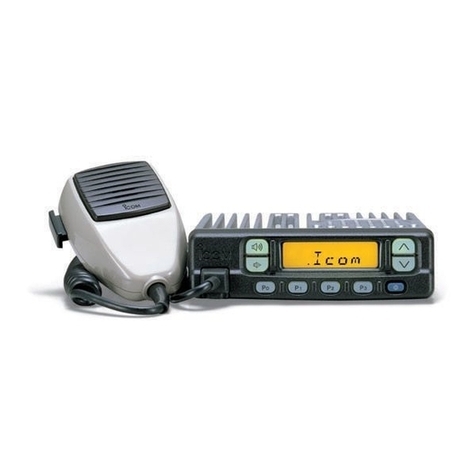
Icom
Icom IC-F310S User manual
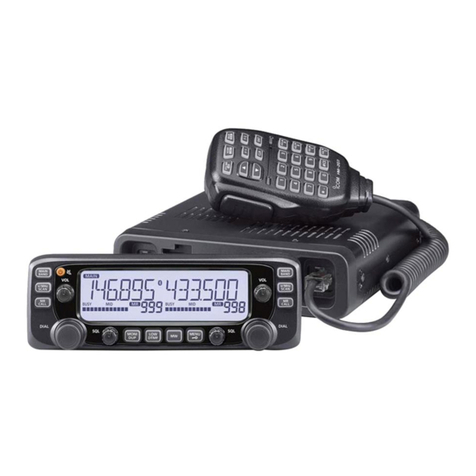
Icom
Icom i2730A User manual

Icom
Icom IC-7300 User manual
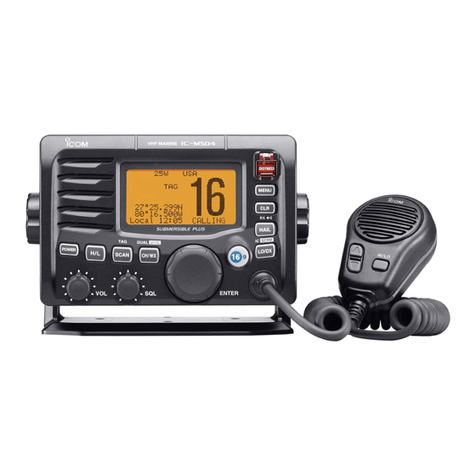
Icom
Icom IC-M504 User manual

Icom
Icom IC-F40GT User manual

Icom
Icom IC-77 User manual

Icom
Icom IC-W32A User manual
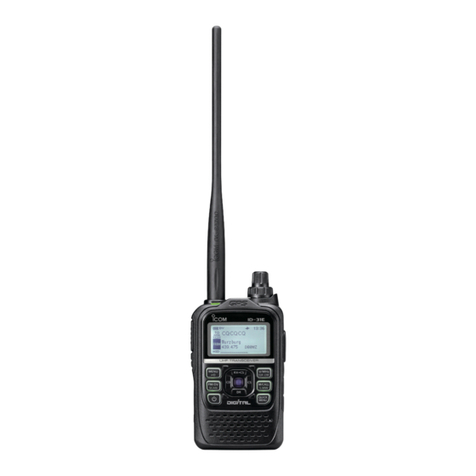
Icom
Icom D-STAR ID-31A; D-STAR ID-31E User manual
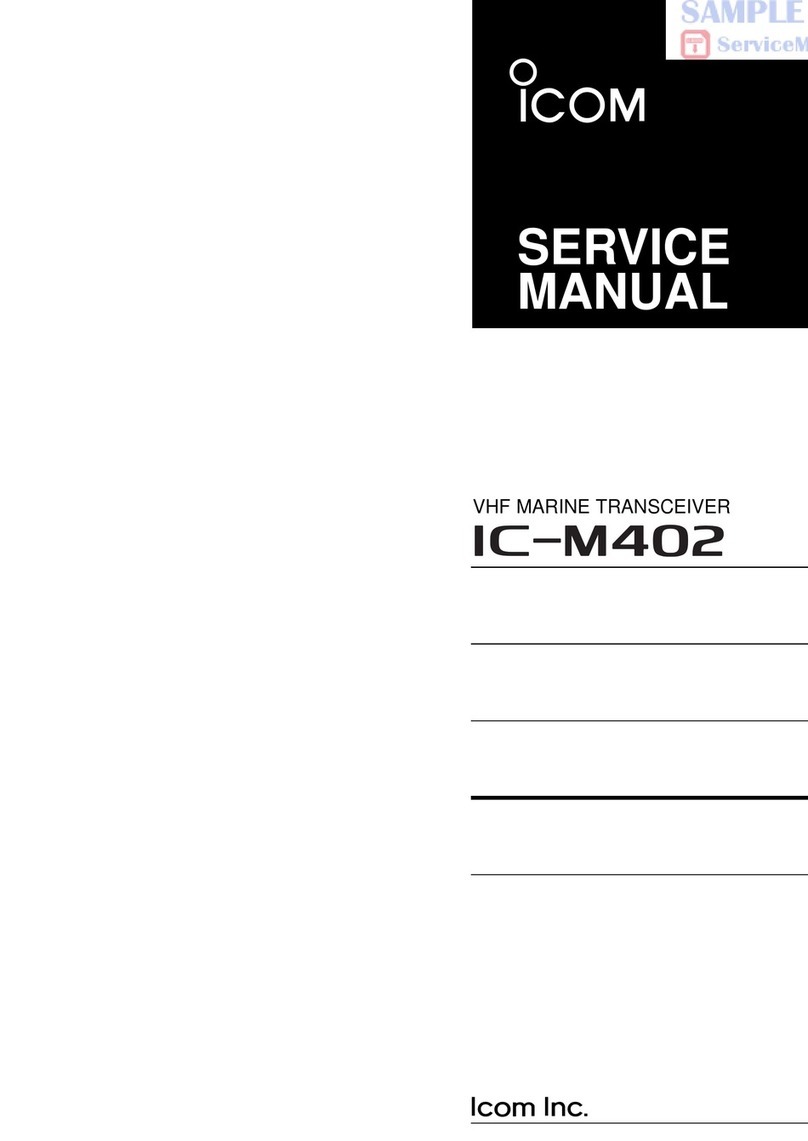
Icom
Icom IC-M402 User manual
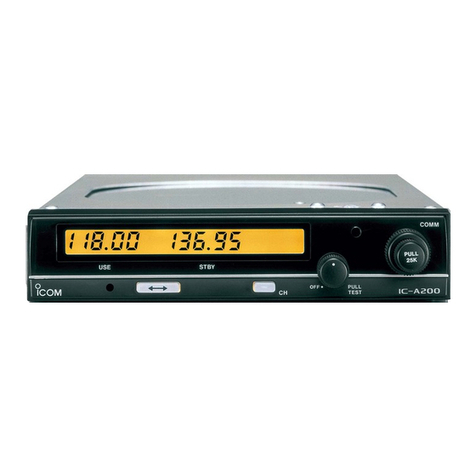
Icom
Icom IC-A200 User manual
Popular Transceiver manuals by other brands
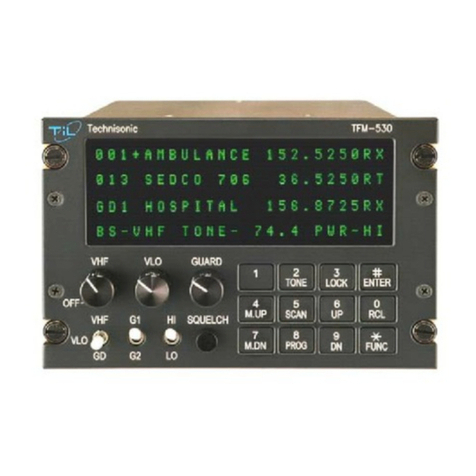
Technisonic Industries Limited
Technisonic Industries Limited TFM-530 Installation and operating instructions
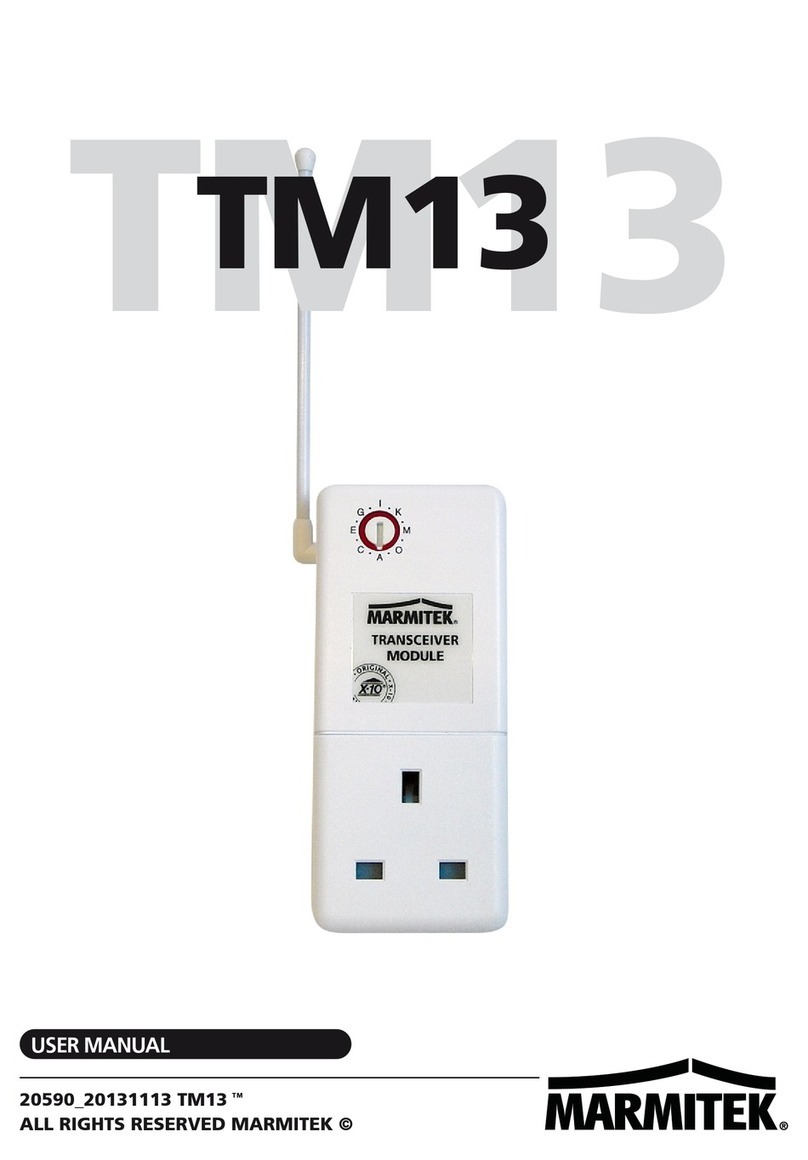
Marmitek
Marmitek Home Control TM13 user manual
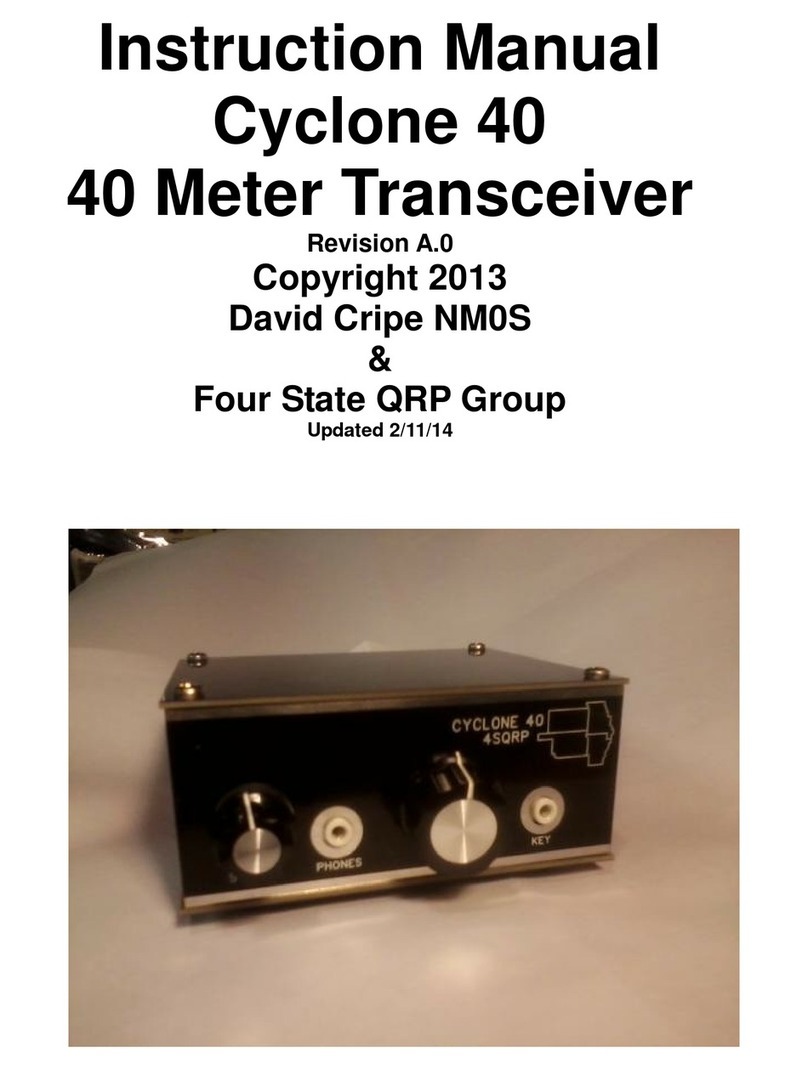
Four State QRP Group
Four State QRP Group Cyclone 40 instruction manual

Entel
Entel HT644 GMDSS user guide

Codan
Codan 5700 series Reference manual
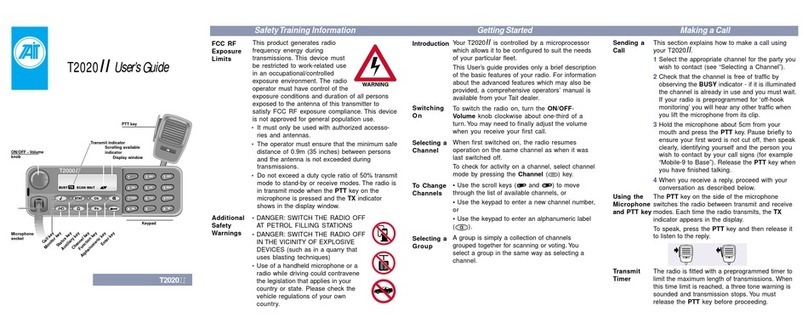
Tait
Tait T2020 Series II user guide
